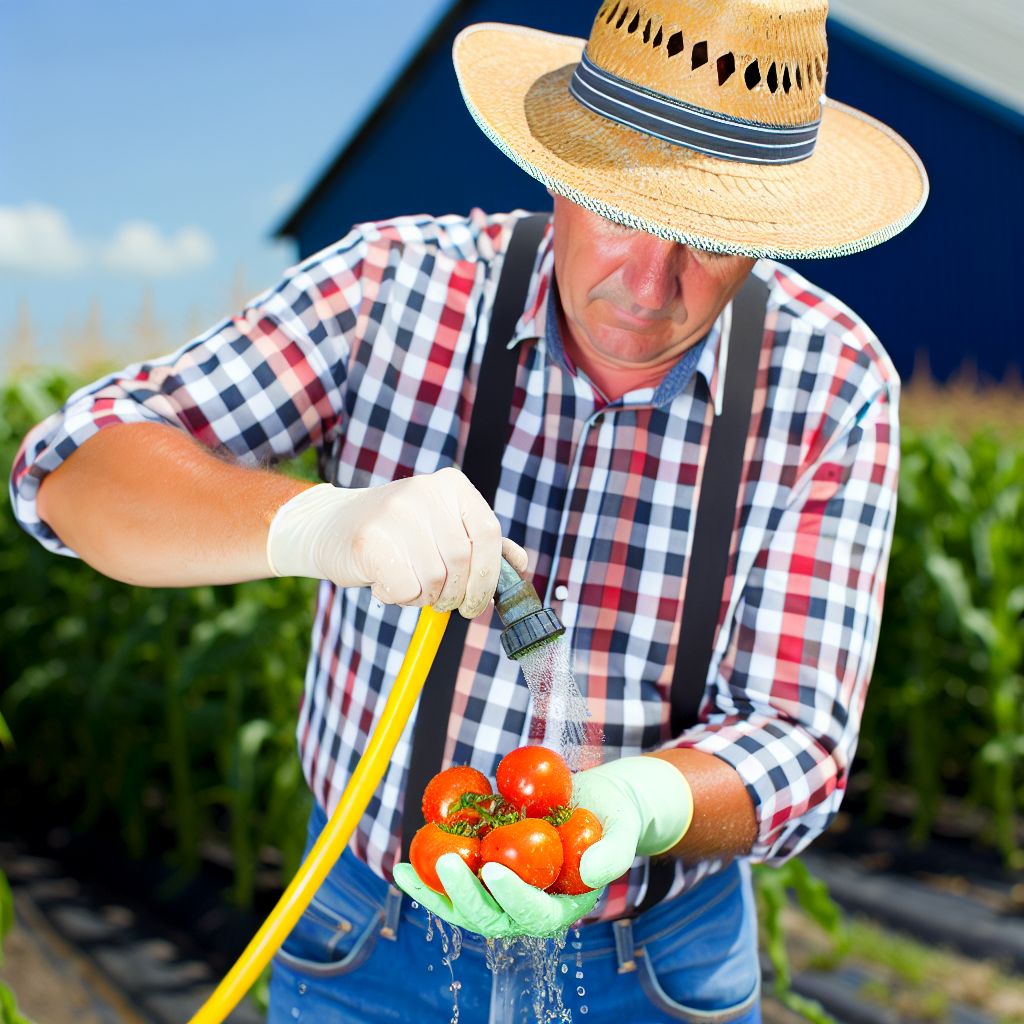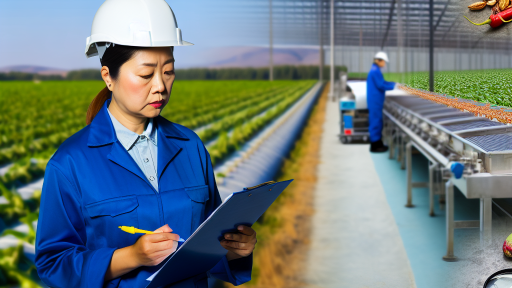Understanding the Importance of Food Safety on Farms
Protecting Consumer Health
Food safety practices protect consumer health effectively.
Farm-fresh produce can harbor harmful pathogens.
Implementing safe handling procedures reduces illness risk.
Additionally, this enhances consumer trust in your products.
Complying with Regulations
Farms must comply with food safety regulations.
These rules ensure that food products meet safety standards.
Non-compliance can result in legal actions and fines.
Therefore, understanding the laws is essential for all farmers.
Enhancing Product Quality
Effective food safety practices enhance product quality.
Consumers prefer fresh produce that is handled safely.
Improved quality directly correlates with higher sales.
Moreover, quality assurance increases your market reputation.
Reducing Waste and Loss
Implementing safety measures reduces waste and loss significantly.
By preventing contamination, you save valuable resources.
Efficient handling leads to less spoilage during storage.
Transform Your Agribusiness
Unlock your farm's potential with expert advice tailored to your needs. Get actionable steps that drive real results.
Get StartedConsequently, this maximizes your overall farm productivity.
Increasing Market Competitiveness
Adopting food safety practices boosts market competitiveness.
Consumers are increasingly aware of food safety issues.
By prioritizing safety, you differentiate your products.
This can lead to enhanced sales and customer loyalty.
Building a Culture of Safety
Creating a culture of safety fosters accountability on the farm.
Employees should understand the importance of food safety.
Training sessions can increase awareness among staff.
Furthermore, consistent practices ensure that safety becomes a habit.
Identifying Common Food Safety Hazards in Agriculture
Introduction to Food Safety Hazards
Food safety hazards are critical issues in agriculture.
These hazards can lead to foodborne illnesses and contamination.
Identifying them is essential for ensuring public health.
Biological Hazards
Biological hazards include bacteria, viruses, and parasites.
Microorganisms like Salmonella and E. coli pose significant threats.
Contamination can occur at any stage of production.
Implementing sanitation measures helps reduce these risks.
Sources of Biological Hazards
Common sources of biological hazards include contaminated water and soil.
Animals can also introduce harmful pathogens onto farms.
Monitoring livestock health is crucial for food safety.
Additionally, improper handling during harvesting increases risks.
Chemical Hazards
Chemical hazards encompass pesticides, fertilizers, and additives.
Residues from these substances can contaminate food products.
Applying chemicals according to guidelines minimizes safety risks.
Regular testing for chemical residues is essential for compliance.
Showcase Your Farming Business
Publish your professional farming services profile on our blog for a one-time fee of $200 and reach a dedicated audience of farmers and agribusiness owners.
Publish Your ProfileSources of Chemical Hazards
Common sources include agricultural inputs and improperly stored chemicals.
Understanding label instructions prevents unintentional misuse.
Furthermore, educating farm workers improves safety standards.
Physical Hazards
Physical hazards refer to foreign objects found in food products.
Examples include stones, metal fragments, and plastic pieces.
These contaminants can cause injury to consumers.
Implementing thorough inspection processes is key to prevention.
Sources of Physical Hazards
Physical hazards often originate from equipment malfunctions.
Poor maintenance practices can contribute to contamination risks.
Furthermore, inadequate employee training may lead to oversight.
Preventing Food Safety Hazards
Preventive measures are essential for effective food safety management.
Implementing a Hazard Analysis Critical Control Point (HACCP) plan is beneficial.
This systematic approach identifies potential hazards at various stages.
Regular training for staff keeps safety practices updated.
Monitoring and Documentation
Maintaining accurate records enhances traceability in food safety.
Monitoring responses to identified hazards is crucial.
This documentation assists in compliance and accountability.
Additionally, it helps in conducting audits and evaluations.
Establishing Standard Operating Procedures for Safety
Defining Your SOPs
Start by clearly defining what your Standard Operating Procedures (SOPs) will cover.
Focus on critical areas affecting food safety on your farm.
Common areas include handling, processing, and storage of food products.
Clearly document each procedure for easy reference.
Involving Your Team
Engage your team members in the development of SOPs.
Solicit input from those who will execute the procedures.
This inclusion fosters ownership and adherence to practices.
Regular training sessions will reinforce the importance of these procedures.
Implementing the SOPs
Roll out the SOPs with clear instructions for every team member.
Assign specific responsibilities to ensure accountability.
Make sure everyone understands their role in food safety.
Utilize checklists to maintain consistency in daily operations.
Regular Review and Updates
Set regular intervals for reviewing your SOPs.
Adjust them based on new information or changing regulations.
Incorporate feedback from team members to improve practices.
Keeping SOPs up to date is essential for ongoing compliance.
Measuring Effectiveness
Establish metrics to evaluate the performance of your SOPs.
Regularly monitor compliance and effectiveness in practice.
Utilize audits to identify any deficiencies in your procedures.
Make improvements based on the results of these evaluations.
Discover More: Agricultural Zoning: Best Practices for Farmers
Implementing Good Agricultural Practices to Enhance Food Safety
Understanding Good Agricultural Practices
Good Agricultural Practices focus on food safety and quality.
Showcase Your Farming Business
Publish your professional farming services profile on our blog for a one-time fee of $200 and reach a dedicated audience of farmers and agribusiness owners.
Publish Your ProfileThese practices reduce risks throughout the food supply chain.
Farmers must implement these strategies effectively.
Key Components of GAP
Effective GAP includes several essential components.
- Soil management ensures healthy crop production.
- Pest control protects crops from harmful organisms.
- Water quality management is vital for irrigation.
- Harvesting techniques impact food safety directly.
Training and Education
Training is crucial for farm workers.
Workers should understand food safety principles.
Regular workshops help keep everyone informed.
Additionally, resources from local agricultural offices are beneficial.
Record Keeping and Traceability
Maintain accurate records of all agricultural activities.
Documentation helps trace products from farm to table.
This process enhances accountability and response to food safety issues.
Implementing traceability systems ensures compliance with regulations.
Regular Audits and Assessments
Conduct regular audits of food safety practices.
Assessments help identify areas for improvement.
Creating an action plan based on findings enhances safety measures.
Furthermore, third-party audits can provide valuable insights.
Uncover the Details: How Tariff Changes Can Affect Your Farming Business
Training and Educating Farm Workers on Food Safety Protocols
Importance of Food Safety Training
Training is essential for maintaining food safety on farms.
It helps workers understand potential hazards in food production.
Moreover, training ensures compliance with legal requirements.
Effective training leads to fewer food safety incidents.
In turn, this protects public health and farm reputation.
Developing a Training Program
Start by assessing the specific needs of your farm.
Identify the key food safety topics relevant to your operations.
Topics may include proper hygiene, sanitation, and pest control.
Next, create training materials that are clear and accessible.
Use visuals and real-life examples to enhance understanding.
Implementing the Training
Schedule regular training sessions to keep information fresh.
Consider using a mix of classroom and hands-on training.
Encourage questions and discussions during sessions.
Furthermore, tailor training to different worker roles.
This approach ensures each worker understands their responsibilities.
Evaluating Training Effectiveness
Assessment is crucial to gauge the impact of training.
Use quizzes and practical evaluations to measure knowledge retention.
Receive feedback from workers to improve future sessions.
Additionally, monitor food safety incidents after training.
Evaluate whether training leads to improved safety practices.
Ongoing Education and Refresher Courses
Food safety training should be an ongoing effort.
Organize refresher courses to reinforce critical concepts.
Stay updated with the latest food safety regulations and practices.
Encourage a culture of continuous learning on your farm.
Showcase Your Farming Business
Publish your professional farming services profile on our blog for a one-time fee of $200 and reach a dedicated audience of farmers and agribusiness owners.
Publish Your ProfileUltimately, ongoing education supports long-term food safety goals.
Uncover the Details: Exploring the Effects of Farm-To-Table Policies on Crop Production

Using Technology and Tools for Monitoring Food Safety
Importance of Technology in Food Safety
Technology plays a crucial role in enhancing food safety practices on farms.
By adopting advanced tools, farmers can monitor safety parameters effectively.
This not only mitigates risks but also boosts consumer confidence.
Types of Monitoring Tools
There are various tools available for food safety monitoring.
Temperature sensors help track storage conditions in real-time.
Moreover, pH meters assist in ensuring proper acidity levels for food preservation.
Farming software manages records and compliance documentation efficiently.
Temperature Sensors
Implementing temperature sensors is essential for perishable goods.
These devices can provide alerts for any temperature fluctuations.
Thus, they help maintain optimal conditions for food storage.
pH Meters
Using pH meters guarantees foods are within safe acidity ranges.
This is vital for preventing spoilage and pathogen growth.
Regular checks can enhance overall food safety standards on farms.
Data Management and Analysis
Effective data management supports better food safety practices.
Farmers can analyze trends and identify areas needing improvement.
Utilizing cloud-based systems enables easy access to data anytime.
Implementing Software Solutions
Adopting software tailored for food safety enhances operational efficiency.
Such solutions assist in tracking compliance and quality control.
Additionally, they streamline reporting processes for audits.
Training and Support
Proper training maximizes the potential of monitoring tools.
Farmers should ensure all staff members understand technology use.
Ongoing support fosters continued compliance and food safety improvements.
Case Studies of Successful Implementation
Examining real-life examples provides practical insights.
A local farm implemented temperature control sensors with great success.
This reduced spoilage rates drastically and improved product quality.
Another farm utilized data analytics for quality control.
As a result, they enhanced their products and customer satisfaction.
These cases highlight the positive outcomes of technology adoption.
Delve into the Subject: Impact Of Pesticide Regulations On Crop Production
Conducting Regular Audits and Inspections for Compliance
Importance of Regular Audits
Regular audits are crucial for ensuring food safety on farms.
They identify potential risks and help implement corrective measures.
Moreover, audits help maintain compliance with local regulations.
Types of Audits
Conduct different types of audits to cover all aspects of food safety.
Internal audits focus on assessing your own practices.
External audits, on the other hand, provide an unbiased review.
Developing an Audit Schedule
Create a comprehensive schedule for regular audits.
Include both planned and random audits within your schedule.
This ensures consistent checks and balances throughout the year.
Showcase Your Farming Business
Publish your professional farming services profile on our blog for a one-time fee of $200 and reach a dedicated audience of farmers and agribusiness owners.
Publish Your ProfileChecklist for Effective Inspections
Develop a detailed checklist for inspections.
Some key areas to review include hygiene practices and storage conditions.
Additionally, check equipment cleanliness and employee training levels.
Training Staff for Effective Audits
Train staff on the importance of audits and inspections.
Ensure they understand how to conduct them effectively.
This promotes a culture of food safety on your farm.
Using Technology for Monitoring
Leverage technology to enhance your auditing processes.
Use specialized software to track compliance and findings.
This ensures accurate data collection and streamlined reporting.
Maintaining Records and Documentation
Maintain thorough records of all audits and inspections.
This documentation is essential for traceability and accountability.
Regularly review and update records to keep them current.
Continuous Improvement
Utilize audit findings to drive continuous improvement.
Implement changes based on the insights gained from audits.
Encourage feedback from staff to refine practices.
Developing a Crisis Management Plan for Food Safety Incidents
Importance of a Crisis Management Plan
A crisis management plan is essential for any farm.
It prepares you for unexpected food safety incidents.
Additionally, this plan helps to minimize damage and restore confidence.
Key Components of the Plan
Your crisis management plan should include several key components.
- Identification of potential food safety risks.
- Emergency response protocols.
- Communication strategies for stakeholders.
- Training procedures for staff.
Identifying Potential Risks
The first step is to identify potential food safety risks.
This includes understanding the sources of contamination.
Next, assess the likelihood of each risk occurring.
Moreover, evaluate the potential impact on your business.
Creating Emergency Response Protocols
Emergency response protocols help guide your actions during an incident.
Clearly define roles and responsibilities for each team member.
Consider creating checklists to ensure quick responses.
Regularly review and update these protocols.
Developing Communication Strategies
Effective communication is critical during a crisis.
Keep lines of communication open with employees and customers.
Additionally, provide updates to government agencies as required.
Prepare pre-written statements for various scenarios.
Training and Drills for Staff
Proper training ensures that staff knows their roles during an incident.
Conduct drills to practice the response to a food safety crisis.
Simulations can help identify areas for improvement.
Also, provide ongoing education about food safety practices.
Reviewing and Updating the Plan
Your crisis management plan requires regular reviews and updates.
After each incident, analyze the effectiveness of your response.
Incorporate feedback to improve future efforts.
Stay informed about new food safety regulations and practices.
Additional Resources
Humane Methods of Slaughter Act | National Agricultural Library
Showcase Your Farming Business
Publish your professional farming services profile on our blog for a one-time fee of $200 and reach a dedicated audience of farmers and agribusiness owners.
Publish Your ProfileGood Agricultural Practices (GAP) Audits | Agricultural Marketing …




